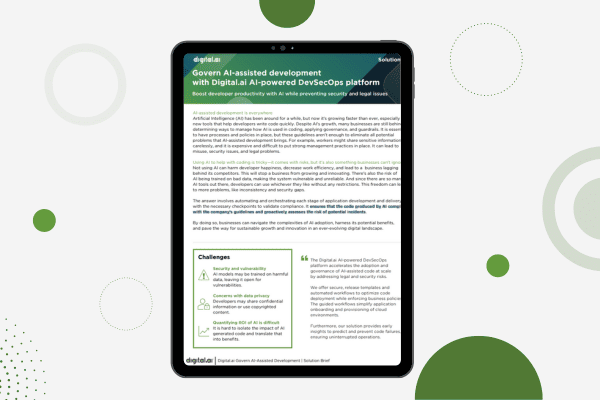Understanding and Measuring Change Failure Rate (DORA)
Learn about Change Failure Rate and its critical role in DevOps. Understand the metrics, factors affecting success, and strategies to enhance change management.
Table of Contents
Enterprises must balance innovation and stability when delivering innovation to their customers. To help monitor this balance, they measure what’s known as the Change Failure Rate (CFR). As a part of the DORA metrics framework, CFR measures how frequently code changes result in issues when pushed to production. Teams use this metric to assess quality and risk.
This glossary will explain the concept of Change Failure Rate, the factors that influence it, and strategies to reduce it. It will also explore how Digital.ai tools, including [Release and Deploy] and out-of-the-box DORA metrics, help organizations reduce their CFR by improving collaboration, automating processes, and providing real-time insights.
Definition of Change Failure Rate
Change failure rate is the percentage of changes that lead to a failure in production, such as downtime, performance degradation, or bugs requiring rollback. It indicates a team’s ability to deliver stable software and is the key metric that helps teams identify weaknesses in their development and release processes. It also serves as a benchmark for improvement.
Maintaining both speed and stability in delivering software updates is a DevOps requirement. High CFR levels highlight the need for improvements, while lower CFR levels demonstrate reliable and well-tested changes.
Importance in DevOps and IT Operations
Within DevOps, CFR measures operational stability. It reflects the team’s ability to deploy changes quickly without compromising quality.
With Digital.ai’s Release Orchestration tools, teams can track and monitor deployments to mitigate potential risks before they lead to failures. Our DORA metrics capabilities help organizations gain real-time insights into CFR and other key performance indicators (KPIs) that impact deployment success.
Key Metrics and Measurements
The change failure rate is just one of several DevOps metrics. It works alongside metrics like lead time, deployment frequency, and mean time to recovery (MTTR) to provide a complete view of a team’s software delivery performance. When used together, teams can identify bottlenecks and opportunities for improvement.
The formula for CFR:

Factors Contributing to Change Failure Rate
Factors across people, processes, and tools, including team dynamics, change complexities, the deployment process, and technical challenges, can increase the failure rate of changes.
Organizational Culture
When it comes to people, a team’s culture has a role in reducing CFR. Open communication, a commitment to blameless retrospectives, and a culture of continuous improvement all contribute to lowering failure rates. In organizations where collaboration is encouraged, failures are seen as learning opportunities, and teams work together to prevent future issues.
Digital.ai empowers teams to foster a collaborative culture using Agile and DevOps practices. Our platform enables cross-functional collaboration by infusing full visibility for agile teams into the release process.
Experience and Skill Levels
Notably, senior and more experienced teams are generally more adept at anticipating potential problems and applying best practices to avoid failures. Obviously, newer or less experienced teams may encounter more frequent failures as they learn to navigate complex environments.
Digital.ai’s AI-driven insights help teams of all experience levels by providing predictive analytics and real-time feedback, ensuring that decisions are data-driven and mistakes are minimized.
Complexity of Changes
Remember that the level of complexity in the deployed code can also contribute to the likelihood of failure. Simple code modifications with minimal impact are less likely to result in failure, while intricate changes that affect multiple systems pose a greater risk. Take, for example, the situation with CrowdStrike.
Through release automation and CI/CD tools, small, frequent changes are easier to test and deploy. By breaking changes into smaller increments, teams can reduce the risk of failure in production.
Inadequate Testing and Validation
Insufficient testing is a leading cause of failures in production. Without automated testing at scale, changes can be deployed with hidden bugs or performance issues that weren’t caught during development.
To reduce the likelihood of failure and help teams maintain high confidence levels in their deployment, Digital.ai integrates automated testing into the CI/CD pipeline to ensure every change is rigorously validated before it reaches production.
Poor Communication and Collaboration
Failures happen in teams that don’t–or won’t–share the business’s objectives or timelines. Coordination between development, operations, and key stakeholders is required to prevent problems from slipping through the cracks.
To reduce the risk of changes failing due to miscommunication, Digital.ai fosters seamless team collaboration by providing scaled agile capabilities, shared dashboards, and real-time insights to keep everyone aligned throughout the release process.
Impact of High Change Failure Rate
Operational downtime impacts customer satisfaction, and often repeated incidents lead to high change failure rates that cause this downtime. To minimize this disruption, enterprises must resolve incidents quickly and efficiently.
Financial Costs
The cost of failure due to changes goes way beyond the costs of resolving the issue. Downtime can lead to millions of lost revenue and project delays in other areas because resources are diverted to fix the problem.
Digital.ai helps reduce these costs by automating recovery processes and providing predictive analytics to prevent failures before they occur. Our AI-powered Change Risk Prediction tools help identify risky changes early, allowing teams to take action before issues escalate.
Operational Downtime
The longer the downtime, the more frustrated the customer becomes, and it’s an all-hands-on-deck situation across the enterprise. Business processes are disrupted, and leadership is panicked.
To quickly respond, Digital.ai offers automated rollback features. This capability helps teams restore services immediately.
Customer Satisfaction
The longer the failure, the more annoyed the customer becomes. Customer churn is inevitable, and customer referrals become non-existent.
By leveraging Digital.ai’s Release Orchestration tools, organizations can consistently deliver reliable, high-quality updates that keep customers happy and loyal.
Employee Morale
Frequent failures can take a toll on employees. Constant firefighting to fix issues can lead to burnout and lower job satisfaction.
Digital.ai’s continuous monitoring and feedback tools provide teams with insights that help them proactively address potential issues, reducing stress and improving overall morale.
Strategies to Reduce Change Failure Rate
Create best practices to reduce the change failure rate and use a mix of technical improvements and process changes. DevOps research shows that implementing change management processes, enhancing team collaboration, and adopting automated testing can significantly reduce change failure rates and improve deployment outcomes.
Implementing Change Management Processes
A formal change management process can drastically reduce failure rates by ensuring every change is reviewed, tested, and validated before production deployment.
Digital.ai offers change management capabilities that integrate seamlessly with existing workflows, helping teams catch issues early and prevent failures.
Enhancing Collaboration Between Teams
As mentioned, effective collaboration is a strategic part of reducing CFR. Teams that work together and share insights are more likely to prevent failures by aligning goals and identifying risks early.
Utilization of Automated Testing Tools
Automated testing ensures that every change is completely reviewed before deployment. By automating testing, teams can detect and resolve issues before they impact production.
Digital.ai’s integrated testing tools provide continuous validation for every change, helping to maintain quality and reduce failure rates.
Continuous Improvement and Feedback Loops
Continuous improvement is a core tenant of Agile and DevOps practices. Establish continuous feedback loops as part of your continuous improvement program to learn from past failures and implement changes that reduce future risks.
By analyzing previous incidents and studying deployment patterns and failure rates through blameless post-mortems, teams can implement continuous improvement practices that reduce the likelihood of future failures. The team’s total commitment to constantly reviewing performance is necessary to make data-driven decisions.
Digital.ai’s agility tools support continuous improvement practices by providing actionable insights and performance data. Teams can continuously monitor their CFR and other key metrics, using the feedback to refine their processes and improve over time.
Measuring and Analyzing Change Failure Rate
To improve change failure rates, teams must first understand how to measure and analyze it. Monitoring CFR alongside other metrics like lead time and deployment frequency gives a full picture of a team’s performance.
Key Performance Indicators (KPIs)
Tracking CFR is essential for evaluating a team’s software delivery performance. Paired with other KPIs like MTTR, it helps teams identify and improve bottlenecks in their release processes.
As mentioned, Digital.ai’s DORA metrics provide real-time tracking of CFR to help teams identify trends and take immediate action when necessary. We also offer out-of-the-box industry benchmarks so teams understand where they are against optimized metrics and can create improvement plans and goal-setting.
Data Collection Methods
Collecting accurate data on failures and successful deployments from just one tool is not enough to understand how well your team performs. Aggregating data across the team’s tool stack can provide detailed insights into where failures are happening and why.
Digital.ai’s integration capabilities allow teams to collect data from multiple sources for real-time tracking and deeper analysis of failures in a unified data foundation. This helps teams better understand root causes and make informed decisions.
Benchmarking Against Industry Standards
Benchmarking your CFR against industry standards helps teams set realistic goals and understand how they compare to other high-performing teams. It’s also a useful way to identify potential improvements.
As mentioned, Digital.ai provides DORA benchmarking capabilities that are right out of the box so organizations can compare their metrics, including CFR, against industry standards to set meaningful performance goals and track progress over time.
Tools and Technologies to Improve Change Success
Several tools and technologies can help teams reduce their change failure rates by automating processes and improving visibility into deployments. These tools ensure that changes are properly vetted and monitored, minimizing the risk of failure.
DevOps Tools for Continuous Integration/Continuous Deployment (CI/CD)
CI/CD pipelines help teams automate the integration and deployment of code, reducing manual errors and ensuring consistency across deployments.
Monitoring and Observability Tools
Monitoring tools should be adopted to measure the health of production environments to detect and respond to failures quickly.
Configuration Management Tools
Configuration management tools can help maintain consistent environments across deployment targets and reduce the risk of failures due to misconfigurations.
Digital.ai offers robust CI/CD tools that automate the entire deployment process, from integration to production, ensuring that every change is thoroughly tested and validated before it reaches production. Through integrations with leading monitoring tools, our customers have continuous visibility into their deployments and can detect and address failures before they impact their customers. Additionally, with configuration management capabilities, teams can ensure environments are appropriately managed and consistent, reducing the likelihood of failures caused by configuration drift.
Summary of Key Points
- Change Failure Rate (CFR) is a key metric for assessing the reliability of deployments in DevOps and is part of the broader DORA metrics.
- Factors within people, process, and technology, as well as complexity of changes, contribute to a higher CFR.
- High CFR leads to significant financial costs, operational downtime, and reduced customer satisfaction.
- Strategies to reduce CFR include implementing robust change management processes, automated testing, and fostering better team collaboration.
- Measuring and analyzing CFR, along with other key DevOps metrics like lead time and deployment frequency, tracks team performance and identifies areas for improvement.
- Continuous improvement, through non-blaming retros, helps teams reduce CFR over time by learning from past mistakes.
- CI/CD pipelines, monitoring tools, and configuration management can further reduce CFR by automating key processes and providing visibility into production environments.
- With Digital.ai, your organization can reduce change failure rates, streamline deployment success, and streamline DevOps delivery.






